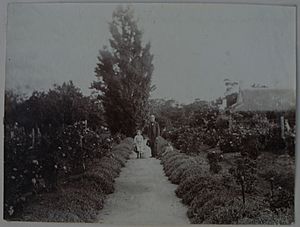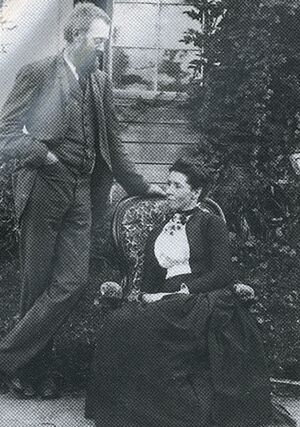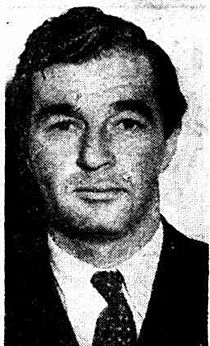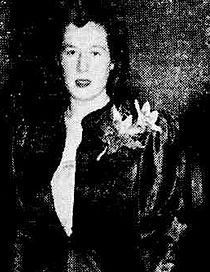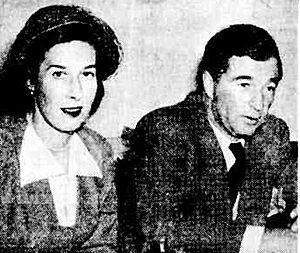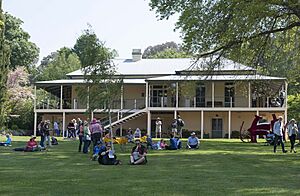Lambrigg, Tharwa facts for kids
Lambrigg is an old property near Tharwa in the Australian Capital Territory. It's listed as a special historical place by the ACT Heritage Council. This was the home of William James Farrer, a very important person who helped the wheat industry a lot. He created a type of wheat that could fight off a plant disease called wheat rust. Lambrigg was the place where Farrer did all his amazing work to create new wheat varieties.
Contents
William and Nina Farrer: A Story of Wheat and Home
William James Farrer was born in England in 1845. His parents were farmers. He was very smart and won many awards, which led him to Cambridge University. He earned his degree there in 1868. Because of his health, he moved to Australia in 1870 when he was 25 years old.
Soon after arriving, William became a tutor in Canberra. He wanted to buy a sheep farm, but he didn't have enough money. In 1875, he became a surveyor. For the next eleven years, he worked for the New South Wales Department of Lands.
In 1882, William married Nina De Salis in Sydney. Nina was the daughter of Leopold De Salis. She was born in 1848. When she met William, she lived on her father's farm near Canberra called Cuppacumbalong. As a wedding gift, Nina's father gave her some land close to Cuppacumbalong. William Farrer named this new property Lambrigg. This was the name of the English village where his family had lived.
The Farrers did not live at Lambrigg right after they got married. They stayed at Cuppacumbalong. William Farrer set up Lambrigg as a working farm. It was only a short horse ride from Cuppacumbalong. He planted a large fruit orchard and a vineyard along the Murrumbidgee River. He also built a large dam. Nina took care of the animals, including horses, sheep, cattle, goats, pigs, turkeys, and chickens. Around this time, Farrer began planting wheat for his experiments.
The first building at Lambrigg was a simple house for the farm worker and his family. It had six rooms and was made of mud. William also had a room there if he needed to stay overnight. This old house is no longer standing, but its foundations can still be seen. A photo from around 1900 shows what it looked like.
The main Lambrigg Homestead was started after 1890 and finished by 1894. Farrer wanted the house to face the river and the north. From the front balcony, you could see the winding Murrumbidgee River and the blue hills. His laboratory, where he did his wheat experiments, was built in 1898. It is a three-room building made of mud with stone floors. It also had a small bedroom for Farrer's assistant.
Around 1890, a financial problem hit farms in Australia. Nina's family, the De Salis family, lost all their properties, including Cuppacumbalong. Lambrigg, however, was safe because it had been given to Nina as a gift. After the main house was finished in 1894, all the families moved to Lambrigg. This included William and Nina, Leopold De Salis, George and Mary De Salis with their seven children, and Henry and Charlotte De Salis with their five children.
William Farrer kept working on his wheat research using his own money. In 1898, he started working for the Department of Agriculture as a wheat expert. He created types of wheat that could resist diseases. This greatly improved the wheat industry in Australia. He died at Lambrigg in 1906 from heart disease and was buried on the property. Nina continued to live at Lambrigg until she died in 1929. She was buried next to William. In 1939, a memorial was built to honor the Farrers, and their graves were included in it.
After Nina's death, the McMurtrie family bought Lambrigg Homestead and lived there until 1941. The Merrivale family then owned the house for eight years.
Jo and Ruth Gullett: Caring for the Garden
Henry Baynton 'Jo' Gullett was born in 1914. His father was Sir Henry Somer Gullett. Jo spent most of his childhood in Melbourne. In 1932, at age 18, he went to Oxford University and earned his degree. Three years later, he returned to Melbourne and became a journalist.
In 1939, when World War II started, Jo joined the army. He fought in the Middle East, Greece, and New Guinea. He was also part of the group that landed in Normandy on D-Day. In 1943, he received a special award called the Military Cross for his bravery. He wrote a book about his war experiences.
In 1946, Jo married Ruth Mary Colman. At this time, Jo was a Member of Parliament for Henty. He had won this position the year before. During his time in Parliament, he was part of a committee for public works. From 1950 to 1956, he was the Government Whip, a role that helps manage votes. He left Parliament in 1956. Later, in 1965, he became the Ambassador to Greece for three years.
In 1949, Jo and Ruth bought Lambrigg. Both of them loved gardening. When they arrived at Lambrigg, most of the Farrer's old garden was gone because it had been neglected. However, some plants were still there, like almond trees, pine trees, elms, poplars, a cedar tree, some climbing roses, and daffodils. Over the next forty years, the couple worked hard to create a beautiful garden. Today, it is one of the most famous gardens in Canberra. Ruth was also very interested in old houses. For many years, she was the President of the National Trust, an organization that protects historical places. She received an award in 1982 for her work.
Lambrigg Today
Today, Lambrigg is still owned by the Gullett family. The property is part of the Open Garden Scheme. This means it is sometimes open for the public to visit and enjoy its beautiful gardens.
Images for kids




